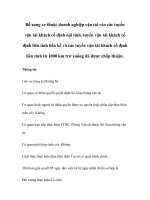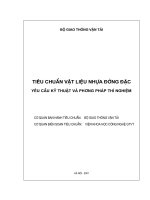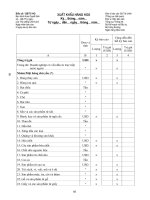TC 1000 users manual
Bạn đang xem bản rút gọn của tài liệu. Xem và tải ngay bản đầy đủ của tài liệu tại đây (265.57 KB, 25 trang )
User’s Manual
Electrolyte Analyzer
1
Contents
1 Introduction ...........................................................................................................................1
1.1 Usage.............................................................................................................................1
1.2 Application......................................................................................................................1
1.3 Principle of Ion Selectivity Electrodes.............................................................................1
1.3.1 Introduction..............................................................................................................1
1.3.2 The Structure of EA Ion Selectivity Electrode...........................................................2
1.3.3 The Principle of Measurement .................................................................................2
1.4 Basic Technical Specifications ........................................................................................3
1.5 The Structure of Analyzer ...............................................................................................3
1.5.1 Front View ...............................................................................................................3
1.5.2 Back View................................................................................................................4
1.5.3 Main Components....................................................................................................4
2 Installation.............................................................................................................................4
2.1 Working Conditions ........................................................................................................4
2.2 Reagents and Consumables ..........................................................................................5
2.3 Unpack and Installation ..................................................................................................6
2.3.1 Check Contents .......................................................................................................6
2.3.2 Installation ...............................................................................................................6
3 Operation ..............................................................................................................................8
3.1 Start-up...........................................................................................................................8
3.2 Setup..............................................................................................................................8
3.3 Main Menu .....................................................................................................................8
3.3.1 Test..........................................................................................................................8
3.3.2 Quality Control.......................................................................................................11
3.3.3 System Setup ........................................................................................................13
3.3.4 System Service......................................................................................................17
4 Maintenance .......................................................................................................................20
4.1 Daily Maintenance........................................................................................................20
4.2 Weekly Maintenance ....................................................................................................20
4.3 Half Year Maintenance .................................................................................................20
4.4 Shut Down Maintenance ..............................................................................................21
4.5 Precautions ..................................................................................................................21
5 Trouble Shooting.................................................................................................................22
5.1 Failure 1 .......................................................................................................................22
5.2 Failure 2 .......................................................................................................................22
5.3 Failure 3 .......................................................................................................................23
5.4 Failure 4 .......................................................................................................................23
2
1 Introduction
1.1 Usage
K+, Na+, Cl- and Ca++ are important constituents of blood. Only if these
constituents are in normal range people can keep fit. SINO-electrolyte
analyzers are based on ISE (Ion selectivity electrode) for measuring ions,
which is quick and accurate. Samples can be whole blood, serum, plasma
and urine.
Before operation, please read the manual carefully!
1.2 Application
The application of EA series is diversified. Details are shown as Table1.
Table1 Application of EA series
Model
Application
TC-1000 Plus
K+, Na+, Cl- ,Ca++ ,PH
TC-1000
K+, Na+, Cl-
1.3 Principle of Ion Selectivity Electrodes
1.3.1 Introduction
The principle is developed according to potentiometer between ion electrode
and reference electrode. Most of salt in electrolyte solution is in ion state. The
electronic exchange between electrode and solution forms an electronic flow
which represents the ion concentration.
Detector
Ion Selectivity Electrode
Reference Electrode
Sample Solution
Ion Selectivity Membrane
Reference Membrane
The above reaction follows the formula of Nernst’s:
1
E=
2.303RT
E0 + -----------nF
㏒ axfx
Where,
E-- The voltage value of ion selectivity electrode in the measured solution
T-- Absolute temperature
E0-- Standard value of voltage of selectivity electrode
F-- Faraday constant
n-- Electric charge of the ion measured
aX-- The activity of ion measured
R-- Gas constant
fX-- The activity modulus of the ion measured
1.3.2 The Structure of EA Ion Selectivity Electrode
EA electrolyte analyzer measures the concentration of ion by using different
models of ion selectivity electrodes, including: K+, Na+, Cl-, Ca++, PH and
reference electrode.
K
Na
Cl
Ca
PH Ref
Test Channel
Ion Selectivity Membrane
Reference Membrane
1.3.3 The Principle of Measurement
Using the method of comparison, electrolyte analyzer measures the
concentration of K+, Na+, Cl- Ca++ and PH. The measurement steps are as
follows:
-- Measure two known standard solutions (standard A and standard B) to get
two potential values of electrode, set up calibrating curve referring to the
measurement.
-- Measure the electrode potential of sample and compares with calibrating
curve to get its result. The following figure shows the measurement principle.
2
MV
Calibrating Curve
MV.B
MV.S
MV.A
Std.A
Sample Std.B
C
1.4 Basic Technical Specifications
The basic technical specifications of SINO-005 or 003 are shown as Table2.
Table2
Basic Technical Specifications
Item
Range
Precision
K
Na
Cl
Ca
0.5-10mmol/L
50-200mmol/L
50-200mmol/L
0.2-5mmol/L
CV≤1.0%
CV≤1.0%
CV≤1.5%
CV≤2.0%
PH
6-9
CV≤1.0%
1.5 The Structure of Analyzer
1.5.1 Front View
Printer
Key Board
Display
Probe
Figure 1
3
1.5.2 Back View
RS232 Connector
Switch
Fuse
Ground Connection
Power Input
Figure 2
1.5.3 Main Components
EA components include electrode holder, pump, valve, waste container,
reagent container as shown in Figure3.
Electrode Holder
Waste Container
Pump
Reagent Container
Valve
Figure 3
2 Installation
2.1 Working Conditions
Power: 220V 50HZ / 110V 60HZ
Temperature: 10℃-35℃
Humidity: < 85%
Others: The analyzer has to keep away from electromagnetism field &
heating source. Also it has to be very well ground connected, avoid exposure
to direct sunlight, ultraviolet and radiation. Moreover, it has to be set in clean
environment.
4
2.2 Reagents and Consumables
Reagents and consumables are shown as Figure 4 – 9.
Standard A
Figure 4
Standard B
Figure 5
De-protein Solution
Figure 6
Electrode Electrolyte
Figure 7
Reference Electrolyte
Figure 8
5
Print Paper
Figure 9
2.3 Unpack and Installation
2.3.1 Check Contents
Once the goods is received, please check its package and contents referring
to packing list. For any damage or loss, please contact forwarder or our local
distributor.
2.3.2 Installation
Steps are as follows:
-- Mount the analyzer on surface of a table or a desk.
-- Open the seal of reagent Standard A and B, insert reagent tube in each
container, and then position Standard A and B in reagent chamber referring to
Figure 3.
-- Insert waste tube into the waste container and position the container in the
chamber referring to Figure 3.
Note: The end of tube must reach the bottom of reagent container. But the
waste tube should be placed on the upside of waste container.
-- Install the peristaltic pump tube on the pump wheel shown as Figure 10.
Figure 10
-- Check if the electrodes and the holder are fixed well.
6
Note: The sequence of electrodes from left to right is K+, Na+, Cl¯, Ca++, PH
and Reference electrode.
How to disassemble the electrode holder are shown as Figure 11–13.
a. Disconnect tube as shown in Figure11.
Figure 11
b. Take out the electrode holder as shown in Figure12.
Push the bottom of the holder upward (only a little bit) and then drag
the holder out.
Figure 12
c. Check the electrodes and the holder as shown in Figure13.
Figure 13
7
3 Operation
3.1 Start-up
Press key “POWER”
3.2 Setup
a. “Clindiag EA 5” (or “Clindiag EA-3”, or “Clindiag EA-2”) on display
b. Automatic ring
c. Show “System Testing”
d. Automatic print “Clindiag EA 5” (or EA-3, or EA-2)
e. Show “Flushing!”
f. Show “Calibrate A”
g. 50 to 60s later: show “Cal A __MV “
h. Aspiration of standard B: show “Calibrate B”
i. 50 to 60s later: show” Cal B____MV”
j. In the process of above steps the analyzer automatically calibrates itself.
When the calibration is completed, it is ready for testing. The display shows as
Figure 14.
Main Menu
Test
QC
Setup
Service
Figure 14
3.3 Main Menu
3.3.1 Test
Select ”Test” and then the display shows as Figure15.
Test
Blood Analyze
Urine Analyze
Figure 15
8
3.3.1.1 Blood Analyze
Press “NO” to return to the main menu, select “Blood Analyze” to enter blood
test program. The display shows as Figure16.
Blood Analyze
ID=000
YES
NO
Figure 16
Press “YES”. The display shows as Figure17.
Blood Analyze
Please open probe!
Figure 17
Open probe. The display shows as Figure18.
Please Press Yes!
Figure 18
Place sample tube under probe and make sure the head of probe reaches
the sample. Press key “yes”, the analyzer will aspirate the sample and start
testing. The display shows as Figure19.
Aspirating!
Figure 19
After the sample is aspirated into probe, the probe must be pushed back
within 10 sec, otherwise the analyzer will give an alarm. Now the display
shows as Figure20.
Please Close Probe!
Figure 20
9
After closing the probe the display shows as Figure21.
Testing !
Figure 21
When test is finished, the results are displayed (for example) as Figure22.
CONC.
mmol/l
K=4.00
Na=140.0
Cl=100.0
Ca=1.25
PH=7.38
Figure 22
Then analyzer automatically washes electrode and prints report. The display
shows as Figure23.
Continue?
Figure 23
Press key “Yes” to test another sample; Press “PRINT”, the printer will print
out one more report.
Press “CAL” the analyzer calibrates again.
Press “NO” to return to main menu.
Urine test and QC test run by the same steps as blood test.
3.3.1.2 Urine Test
Choose Urine test to enter urine analysis steps. The display shows as
Figure24.
Urine test
ID=000
YES
No
Figure 24
The process is the same as test blood
10
Note: Urine must be diluted before test. Dilution method: mix 100ul urine
sample with 900ul ion-free water.
3.3.2 Quality Control
3.3.2.1 General Introduction
Thanks to the analyzer’s excellent QC design, we recommend user perform
QC tests by installation, or every month or change reagent or in any necessary
case.
Choose “Q.C.” in the main menu, the display shows as Figure25.
Q.C.
QC-Analyze
QC-Review
QC-Stat.
QC-Delete
Figure 25
“QC-Analyze” is to check if the analyzer can produce correct result or not. If
QC is out of range, the analyzer can not produce correct result and then the
user has to check the instrument and the reagent. EA analyzer can perform
three level controls (high, normal and low.). Choose “QC-Analyze “to enter QC
analysis program, the display shows as Figure26.
QC-Analyze
High
Low
Normal
Figure 26
If user wants to analyze the high level, please choose “High”. The display
shows as Figure27.
High
ID=000
YES
NO
Figure 27
Press “NO” to return to previous page. Press “YES” to confirm.
.
11
3.3.2.2 Data Statistic
According to QC test data, the “QC STAT” function can work out: AVERAGE,
SD and CV.
Select “QC-Stat.” to enter QC stat program, the display shows as Figure28.
QC-Stat.
High
Low
Normal
Figure 28
Choose “High”. If data exists, the display shows as Figure 29.
“11” means 11 QCs are tested and “30” means 30 QC tests can be saved at
this level.
High
11/30
Figure 29
Press key “YES,” the display shows as Figure30.
Statistic!
Figure 30
The display shows the statistic data by following sequence: SD, AVERAGE
and CV.
First is “SD shown as Figure31.
SD
K=X.X
Na=X.X
Cl=X.X
Ca=X.XX
PH=X.X
Figure 31
Press “YES”, the display shows as Figure32.
12
AVERAGE
K=X.XX
Na=XXX.X
Cl=XXX.X
Ca=X.XX
PH=X.XX
Figure 32
Press “YES” again, the display shows as Figure33
CV
K=X.XX
Na=X.XX
Cl=X.XX
Ca=X.XX
PH=X.XX
Figure 33
Press “YES” again to print out all the statistic data.
Press “NO” to go back to QC menu.
If less than 5 QC tests are stored, the analyzer can not give statistics data
and the display shows as Figure34.
Not Enough Data!
Figure 34
Choose “QC-Review” to review the data.
Choose “QC-Delete” to delete all the data.
3.3.3 System Setup
SINO- analyzer’s system has to be set after startup. Choose “Setup” to enter
setup menu. The display shows as Figure35.
Setup
Time
Parameter
Printer
Calibrate
Figure 35
Set up data, time, parameter, printer or the model of calibration.
13
3.3.3.1 Time Setup
Choose “Time” in the Setup menu. The display shows as the Figure 36. Key
“Up” and” Down” can change number and Key “Right” and “Left” perform
modification. Press “YES” to save and then return to the Setup menu. Press
“NO” to cancel.
Time
08-11-13
08:00:00
YES
NO
Figure 36
3.3.3.2 Printer Setup
Choose Printer in the Setup menu, then the display shows as Figure37.
Printer
Auto-Print
Other Print
Figure 37
Then choose Auto-Print, the display shows as Figure38.
Auto Print?
YES
NO
Figure 38
Choose “YES” to print every test result automatically
Set other print function as Figure 39: to activate the print function by selecting
each item. “YES” to print, “NO” not to print.
Other Print
ICa
YES
PH
YES
Range
TCa
YES
NO
Figure 39
14
3.3.3.3 Parameter Setup
Choose Parameter in Setup menu then the display shows as Figure40.
Parameter
Modify
Para
Modify
Range
Figure 40
Choose “Modify Para”, the display shows as the Figure 41. The accuracy of
high value(or middle value) and low value can be changed by adjusting the
slope(k). The fixed error of high, normal and low values can be eliminated by
adjusting intercept (d).
Modify Para
ION:
K →←
K=1.00
d=-00.00
Correction: Y=kc+d
Figure 41
The slope (k) and intercept (d) are obtained according to the calculation of low
value sample and normal value sample and respective target value. According
to the four values (two target values: S1, S2 and two measured values: M1,
M2), the value of k & d can be obtained through formula:
XS2-XS1
K= ------------XM2-XM1
or
d=XS1 – K*XM1
XS3-XS1
K= ------------XM3-XM1
To get the “K” and “d” value, operator must use the controls ranging from high,
normal and low values, of the same manufacturer and the same lot, then
calculate “K” and “d” values based the target values and measured values.
The necessary data is shown as Table3.
15
Table 3
The necessary data for K and d values
Low Value1
Test
Normal Value2
High Value3
Target
Value S1
Measure
Value M1
Target
Value S2
Measure
Value M2
Target
Value S3
(XS1)
(XM1)
(XS2)
(XM2)
(XS3)
Measure
Value M3
(XM3)
K
Na
Cl
Ca
Test all the controls, calculate the “k” and ”d” value, then input “K, d” into the
equipment. If good repetition is obtained, the measured values should be in
accordance with the target ones.
3.3.3.4 Range Setup
The normal range is the test results of healthy people. Choose Modify Range.
The display shows as Figure42.
Modify Range
ION:
K →←
L-2.00
H=8.00
Units:
mmol/L
Figure 42
3.3.3.5 Calibration Setup
Choose “Calibrate”, the display shows as Figure 43. Under “Auto-Cal”., the
device will calibrate automatically after measuring each sample, while under
“Manual-Cal.” users must go back to the main menu to press “CAL” key and
then the equipment will calibrate. If choose “Manual-Cal.”, we suggest to
calibrate after each 5-10 measurements.
Calibrate
Auto-Cal.
Manual-Cal.
Figure 43
16
3.3.4 System Service
EA-analyzer has 4 system service programs as shown in Figure44.
Service
Data
Maintain
Sys. Cal.
Others
Figure 44
3.3.4.1 System Data
Choose ”Data” in the service menu, the display shows as Figure45.
Data
Data
Slope
Del. Data
MV
Figure 45
Choose “Data” to show the data of ID, while press “NO” to return to the main
menu.
Choose “Slope” to show the electrode slope. The normal range is 30-80.
Slope lower than 30 means the electrode is aged and needs to be replaced.
Choose “MV” to show MV. Value. The MV range of each electrode should be
50-120. If lower than 50MV, the electrode needs to be replaced.
If the electrode MV is lower than 50mv, the analyzer can’t pass calibration or
the measurement is not correct.
Choose “Del. Data” to delete all the data.
3.3.4.2 System Calibration
Choose “Sys. Cal.” In the Service menu, the display shows as Figure46.
Two-Point Cal.?
YES
NO
Figure 46
Choose “YES” the device will run two points calibration. It will test Std. A and
Std. B to get the slope. Then test Std. A to check if the result is identical to the
true value of Std.A. If yes, the calibration is passed, otherwise the display
shows “continue calibrating?” Press “YES” to repeat the process of calibration.
17
Attention: If system calibration can not pass by 2 continuous times, press
“NO” to enter the main menu and repeat the calibration after 30mins or ask for
help from local service.
3.3.4.3 Maintenance
Choose ”Maintain” in the Service menu, the display shows as Figure47.
Maintain
Cleaning
Sys.Plus
Checking
Update
Figure 47
3.3.4.3.1 Cleaning
Choose “Cleaning”, the display shows as Figure48.
Cleaning
Please open probe!
Figure 48
At this moment, open the probe to aspirate de-protein solution, then the
display shows as Figure49.
Please close probe!
Figure 49
At this moment close the probe, the display shows as Figure50.
Cleaning
Cleaning!
Waiting!
Figure 50
This is to remove protein from electrode and tube.
18
3.3.4.3.2 Checking
Choose “Checking” in the Maintenance menu, the display shows as Figure51.
Checking
Please Press Yes!
Figure 51
Press “YES”, the device will aspirate Std A automatically. Then the display
shows as Figure52.
Aspirating!
Figure 52
After STD A is aspirated, the display shows as Figure53.
Reading!
Figure 53
12 secs later, the display shows as Figure54.
Checking
MV
K= XX
Na=XX
Cl= XX
Ca=XX
PH=XX
Figure 54
Note: The MV value will be refreshed in 1 second or so. If MV is not
stable after 1 min. refreshing, it indicates MV is not stable, and the electrode
needs to be maintained or changed.
Press “No” to return to previous page.
3.3.4.3.3 Sys.Plus
System Plus is adjusted before the equipment leaves factory. There’s no
need for user to adjust it.
19
3.3.4.3.4 Update
Users do not need to update the system.
4. Maintenance
4.1 Daily Maintenance
-- Checking standard A or B is enough.
-- Checking the waste container is full or not.
-- The analyzer must be calibrated after changing reagent.
-- Prevent air into tube. If the air bubble exists inside the tube, it will cause
error results. There are three ways to eliminate air bubbles:
a. Start-up again.
b. Repeat calibration so that the air bubble can be removed out of electrode.
c. Empty the waste container.
Note: The end of reagent tube must reach bottle’s bottom.
4.2 Weekly Maintenance
Use detergent to remove protein and clean the tube. Removing protein must
be done every week (For large quantity of test, please do it twice), because it
plays an important role for extending the life of electrode. Operate it according
to 3.5.3.1.
4.3 Half Year Maintenance
Change pump tubing.
Change electrode electrolyte.
Electrode electrolyte must be added if the internal solution is reduced
otherwise stability of electrode will be decreased.
How to add electrode electrolyte:
Rotate to open the head of electrode, empty the electrode solution and fill it
full with electrolyte solution by syringe then cover the head. The electrode
electrolyte does not need to be changed if the electrode works well.
Note:
a. The electrode sequence should not be reversed, otherwise air bubble will
enter the electrode. Please remove air bubble before installing electrodes to
20
the holder.
b. When adding electrolyte solution, the needle of syringe should not enter
the electrode for avoiding damage the sensitive membrane.
If the pump tube is used for a long time, the protein will be deposited and
cause wrong test result, so the analyzer must be cleaned regularly.
4.4 Shut down Maintenance
Before shutting down EA please maintain it as follows:
-- Take out reagent bottle and empty it.
-- Rinse to remove reagent inside tube according to set up steps.
-- Turn off electrical source.
-- Take out the electrode and stored.
-- Loose pump tube.
4.5 Precautions
-- EA-analyzer must keep 24 hours running for extending the life of electrode.
-- Performing QC must use electrolyte analyzer control (Ion).
-- No air-bubble in the sample during test or it must be measured again.
-- No air-bubble in the standard solution during calibration or it must be
measured again.
Make sure all of the sample must be:
-- Measure sample as quick as possible. Measurement has to be conducted
within 2 hours after it is collected.
-- Use heparin as anticoagulant.
-- Samples must be stored at room temperature, do not freeze.
-- Hemolysis can increase the K value.
-- Don’t use alkalescent heparin as anticoagulant including EDTA, citrate and
Oxalate.
-- Don’t use any unknown reagent to the instrument, because they may
destroy the performance of ISE ion electrode.
21
5 Troubleshooting
5.1 Failure 1
No Electricity Input
Possible causes:
-- Power out.
-- Power wire is not correctly linked to electricity source.
-- Fuse breaks.
Solutions:
-- Shut down and wait for a moment and turn on again.
-- Make sure the power wire is well connected.
5.2 Failure 2
Deficiency of Repeatability
Possible causes:
-- Electrode is not stable.
-- Electrode is not activated.
-- Leakage between two electrodes.
-- Clot exists in electrode.
-- Contamination exists in the channel of electrode.
-- There is no KCl crystal in the reference electrode.
-- The MV of electrode is lower than 50mv.
-- The slope of electrode is lower than reference slope.
-- Strong interference of electromagnetism.
-- Not enough reagent or reagent has gone bad.
Solutions:
-- Calibrate again after 30 minutes.
-- Fix the electrode well.
-- Take away the electrode & clean dust.
-- Clean with absolute alcohol.
-- Clean electrode.
-- Replace the reference electrode.
-- Calibrate again or replace electrode.
-- Remove the interference source & cover the shield correctly.
-- Replace reagent.
22
5.3 Failure 3
Low Accuracy
Possible causes:
-- "SYSTEM CALIBRATION" not done.
-- "SYSTEM CALIBRATION" can pass but the slope is beyond the limit.
-- The veracity of all items is not good.
-- The reagent goes bad.
-- k/d not set.
Solutions:
-- Do "SYSTEM CALIBRATION" 2 to 3 times.
-- Replace the corresponding electrode or reagent.
-- Replace the reference electrode.
-- Replace reagent.
-- Set k/d.
5.4 Failure 4
No Sample Sucked & Air Bubbles Inside Tube
Possible causes:
-- Sample probe or tube is blocked.
-- Tee connector is blocked.
-- Electrode is blocked.
-- Tube aged.
-- The tube is broken/ leaked.
Solutions:
-- Clean probe.
-- Clean channel.
-- Clean electrode.
-- Replace tube.
-- Reinstallion of tube.
-- Replace pump tube.
23









